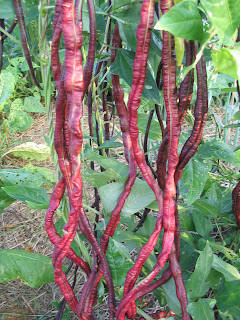One of the first things I did upon getting to DR was start a garden. People at Skyhouse let me use a few beds of their garden at first and then I added to my garden space by renting a piece of land next to the Skyhouse garden.


This area had not really been gardened for awhile so it was a tough job getting all the beds laid out.

I wound up with a huge pile of sod that I've been composting all season. Ananda came to visit me about a month after I arrived and helped me get this garden established.


I was able to begin planting in this new garden in June or so, a little late for this region. I've planted a lot of bean varieties, peppers, tomatoes, carrots, eggplant, parsnip, basil, epazote, summer squash, muskmelons, watermelon, cucumbers, broccoli, cabbage, onions, scallions, walking onions, Chinese cabbage, beets, cauliflower, corn, cilantro, garlic, and celery.

One thing I was really happy to be able to grow this season was corn. In Madison, if you plant corn it will get eaten by raccoons as soon as it gets close to being ripe, so there really was no point in growing it there. Here I was able to grow it, but the only things interfering with a good harvest were the soil and the rats. This new garden was not very fertile, so the corn grew, but didn't produce much. Only one variety really produced good sweet corn, and the popcorn did well. I planted pole beans with one flour corn variety, and this made the plants lush, green and productive, but then the rats were able to scale the beans to reach the grain and they ate it all. I'm going to have to figure out a better way, because I love corn.




These are pictures of the garden about a month after planting. After planting the garden, I needed to figure out some way to irrigate. I'd been used to gardening with a water spigot within a hose reach of my garden, but at DR there are no spigots. There was an old cistern that had been used in the past by a former gardener near the machine shed, and it wasn't collecting water anymore. I decided to have that moved over to a building closer to my garden and to other water-intensive activities.

I also installed a few rain barrels on the Skyhouse garden shed to collect water off that roof too. Unfortunately, the dry spell that lasted about two months this summer had already begun when I finished these water catchment systems, so I didn't really get to test them until later in the season. In the meantime, I used the Skyhouse and common house greywater system to irrigate. Wastewater from the kitchens and showers flows into a filter pond planted in water plants before it makes its way through a pipe to the cattail pond. We use biodegradable detergents and soaps, so the water is ok to put on the plants. In fact the part of the Skyhouse garden where the greywater used to drain is incredibly fertile.



I was able to overcome my mulching difficulties by getting newspaper from the local Memphis Democrat, which I spread between rows before covering it with hay and straw. In Madison, I'd always had access to leaf mulch, something not so abundant out here in the country.
I could water, and I didn't have to weed anymore, so I mostly spent my time watering and watching stuff grow. The harvest has been good, though there were some surprise pests and notable absences of pests gardening in a new region. There were strange new bean beetles, and blister beetles, that ate the leafy greens, along with the usual flea and cucumber beetles.

This is a pizza Brian and I made with nearly all garden and local ingredients. The basil, tomatoes, garlic, and onions came from our garden, the wheat (freshly milled) came from Sandhill, a nearby community, and the cheese (homemade mozzarella) came from milk from the organic dairy only about a mile down the road. One pizza was topped with homemade tofu I made with soybeans grown at Sandhill. The only non-local ingredients were oil, salt, and a few of the spices. It was probably the best pizza I've ever had. Next time I want to make it with cheddar cheese.

My garlic harvest was pretty good considering I planted it in the spring. I plan to plant a lot of it this fall and have a bumper crop next season. I've continued to fill in and plant more crops when I've harvested something. I planted cauliflower, cabbage, and broccoli as fall crops and they are huge now and setting fruit, or rather setting vegetables.

I eat at Bobolink eating co-op and I'm able to count my gardening time towards my food bill. I've put in enough hours this season to offset my food bill entirely. I've also provided a lot of food for Bobolink.




